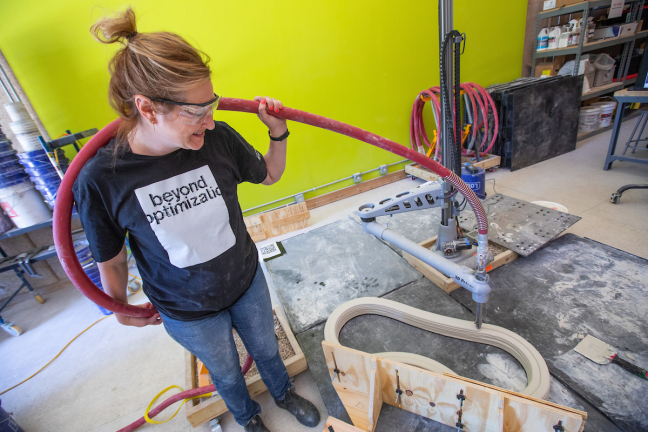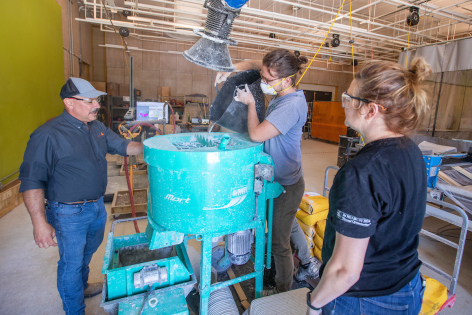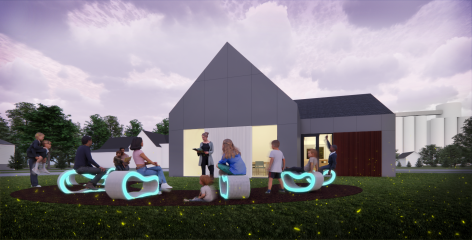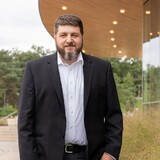
Shelby Doyle monitors the nozzle of a 3D concrete printer at Iowa State as it fabricates a piece for the Rudd Public Library. Photo by Christopher Gannon/Iowa State University. Larger image.
AMES, Iowa – An innovative collaboration between Iowa State University and the private design firm OPN Architects will result in a unique installation for a recently opened public library in Rudd, Iowa, after a tornado destroyed the previous building.
The collaboration merges ISU’s research and 3D-printing facilities with OPN’s digital tools and vision to create an outdoor seating space to be installed this summer at the new Rudd Public Library, which replaces a building that was destroyed by a tornado in December 2021.
For Justin Bishop, a principal at OPN and 2004 ISU architecture graduate, the project is personal. Bishop grew up in Rudd and led the design of the new library, which officially opened its doors to patrons in April. Bishop called the library an important “core memory” of his youth. It provided the setting for countless community events and was a regular stop on summer days when he didn’t have to go to school. In fact, Bishop’s mother served on the library board.
That’s why it was so painful years later when Bishop saw news coverage of the aftermath of the tornado that ripped through Rudd on Dec. 15, 2021, leaving the library in ruins.
“The roof was gone and walls were splayed out and books scattered everywhere,” Bishop recalls.
He knew he wanted to help his hometown rebuild, and working as an architect gave him that opportunity. OPN was selected to design the new community library, and Bishop jumped at the opportunity to lead the project. The roughly 1,500-square-feet building features modern touches such as cement boards, metal panels and commercial glazing while remaining true to the town’s rural character. Bishop said current members of the library board and Rudd residents embraced the mix of modern and classic design.
A university-industry partnership

Jacob Gasper of OPN Architects pours water into a mixer while preparing micro-concrete for 3D printing. Shelby Doyle, associate professor of architecture, looks on at right, and Noah Callantine of Sika 3D is at left. Photo by Christopher Gannon/Iowa State University. Larger image. |
OPN teamed up with Iowa State University’s 3D Affordable Innovative Technologies Housing Project to use on-campus 3D printers to craft the outdoor seating installation out of concrete. 3D printing with concrete is a new and largely untested technology, and ISU researchers like Shelby Doyle, an associate professor of architecture and the Stan G. Thurston Professor in Design Build, have spent over two years answering foundational questions about its uses in construction. OPN and Iowa State personnel had been seeking projects that would present an opportunity to use 3D printers for a public project. The Rudd Library fit the bill.
Iowa State provided workspace, the 3D printer and associated equipment, while OPN led the design of the project. OPN designers incorporated augmented reality into the installation by using AR goggles to visualize the necessary curvature of the rebar reinforcements inside the concrete pieces, ensuring each component would be precisely the right shape and size.
In early June, OPN employees spent several days working with a 3D printer in the Communications Building on the ISU campus. The roar of a concrete mixer filled the studio as Doyle and the OPN employees fed concrete through a hose into a nozzle attached to the robotic arm of the 3D printer. The machine methodically and precisely deposited layer after layer of concrete on a platform, gradually creating the form of one of the pieces to be installed at the Rudd library.
Doyle said the partnership with OPN has created an exciting and rare opportunity for cutting-edge digital fabrication work to be displayed in rural Iowa. Both OPN and Iowa State contributed expertise and external relationships that made the project possible.
“There’s a lot of interest in 3D printing, but there’s not a lot of opportunities for architecture firms to try it without having to commit to a high level of investment,” Doyle said. “This is a way for OPN to work with ISU’s equipment and to learn the possibilities of a new technology. And for our team at ISU, it’s an opportunity to create, share and apply knowledge within and beyond the research lab.”
Bishop said partnering with Iowa State is an opportunity for OPN to realize its commitment to pushing design boundaries with technology.
“There’s a symbiotic relationship here that I hope is just the start,” Bishop said. “We’re excited to support this as a firm because it aligns with what we want to do and where we want to go.”
The 3D Affordable Innovative Technologies Housing Project, or 3D AIT Housing Project, began in 2022 when the Iowa Economic Development Authority awarded the ISU research team a $2.1 million grant to work with Iowa Central Community College and a private construction firm to analyze basic research questions regarding emerging construction technologies such as 3D printing with concrete.
The Rudd library collaboration pushed the boundaries of the young technology, and Doyle said the team learned as the process unfolded. For instance, they learned to closely monitor the temperature of the water they used to mix with the concrete. Early attempts with tap water that was too warm caused the specialty concrete mix from Sikacrete to cure incorrectly, yet another variable for researchers to analyze before the concrete can be used at outdoor work sites, where temperatures and humidity can swing drastically.
Melding art and science

A rendering of the installation for the new Rudd Public Library that resulted from a collaboration between Iowa State University and OPN Architects. Courtesy of OPN. Larger image. |
Jacob Gasper, a 2021 ISU architecture graduate and member of OPN’s innovation team, said the pieces designed for the library are as much an art installation as public seating. The installation features seven separate concrete pieces that will allow library patrons to sit or recline on them, similar to benches. But the pieces resemble winding figure eight shapes with curvilinear forms that look nothing like a traditional park bench or picnic table. The pieces will form a semicircle, creating a public space reminiscent of an amphitheater. But the spacing of the pieces allows for a sense of privacy and seclusion for anyone looking to relax and get a breath of fresh air, Gasper said.
“We wanted something artistic that looked nice and took advantage of the sloping curves made possible by a concrete 3D printer,” he said.
No two of the seven pieces in the installation are exactly alike in shape or dimension, an advantage created by the 3D printer. Gasper said pouring concrete usually requires the use of a mold, a technique good for churning out numerous copies of the same piece. But the 3D printer can create customized shapes without a mold.
“We wanted to make each of our seven objects slightly different to show off the power of this technology,” he said.
Contacts
Shelby Doyle, Architecture, doyle@iastate.edu
Fred Love, News Service, 515-294-0704, fredlove@iastate.edu
Quick look
An innovative collaboration merges Iowa State University’s research and 3D-printing facilities with a private design firm’s digital tools and vision to create an outdoor seating space to be installed this summer at the new Rudd Public Library. The old Rudd library was destroyed by a tornado in December 2021. The pieces designed for the library are as much an art installation as public seating, featuring seven separate concrete pieces that will allow patrons to sit or recline, similar to benches.
Quote
“There’s a lot of interest in 3D printing, but there’s not a lot of opportunities for architecture firms to try it without having to commit to a high level of investment. This is a way for OPN to work with ISU’s equipment and to learn the possibilities of a new technology. And for our team at ISU, it’s an opportunity to create, share and apply knowledge within and beyond the research lab.”
Shelby Doyle, associate professor of architecture and the Stan G. Thurston Professor in Design Build
